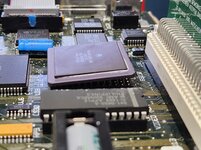Like most people it seems, at least in the US, I used the HWS4514 socket from Phoenix Enterprises for the 68030 on my Reloaded board, because it's under $5 with no minimum order quantity. I have to say, though, I'm not very satisfied with it. The force required to insert and remove the CPU in that socket is absurdly high; many times greater than the original socket on my other SE/30 board.
The other readily available option is the Mill-Max 510-43-128-13-041001 on Digi-Key for $30 apiece. At that price, it had better be a joy to use, but I'd rather find a more affordable option.
So, does anyone have a source for PGA-128 sockets that they actually like, or should I just resort to cutting and soldering single-row machine pin header strips to the board?
The other readily available option is the Mill-Max 510-43-128-13-041001 on Digi-Key for $30 apiece. At that price, it had better be a joy to use, but I'd rather find a more affordable option.
So, does anyone have a source for PGA-128 sockets that they actually like, or should I just resort to cutting and soldering single-row machine pin header strips to the board?

